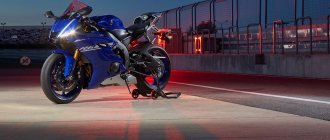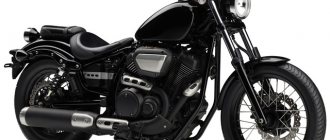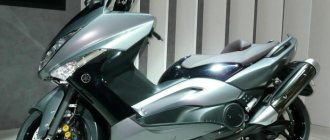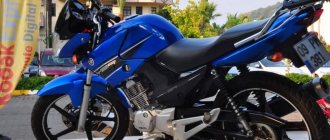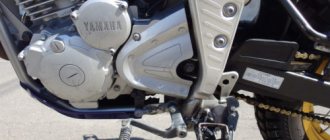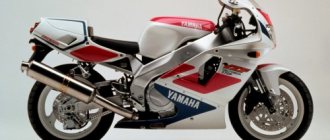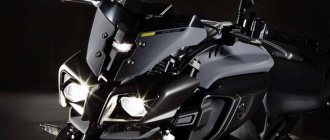Japanese motorcyclesYamaha motorcycles
One of the most legendary motorcycles ever produced.
When you first look at it, you realize that there is not a toy in this brutal and aggressive beauty. Born in the land of the rising sun, he does not at all correspond to the Japanese style.
This motorcycle is designed to provide adrenaline and frantic energy to its riders.
The rebirth, which followed in 2008, gave this monster an engine with increased power, an improved chassis and a more aggressive design.
Yamaha V-Max
Yamaha V-Max: 1984 - 2007, 1198 cm3, 145 hp, 140,000–360,000 rub.
Yamaha V-Max: 1984 - 2007, 1198 cm3, 145 hp, 140,000–360,000 rub.
BEGINNING OF THE STORY. Having seen drag racing so beloved by Americans, Mr. Araki from Yamaha (later the head of the project), who came to the USA to study the market, decided that it was simply blasphemous to miss the opportunity to make money on a popular hobby.
Returning to Japan, he convinced the management of the need to build a device that later became one of the main legends of the motorcycle world - the Yamaha V-Max. The new device, which does not fit into the framework of any class, was first presented at the Las Vegas Motor Show in 1984 as a 1985 model. The 1200 cc V-four, taken from the XVZ1200 Venture grand tourer, was boosted with 97 hp. at 7000 rpm to 145 hp, phenomenal for those times. at 9000 rpm (121 Nm at 7500 rpm). The motorcycle was created as a “tribute” to American hot rods with huge V-shaped “eights” that “folded the asphalt like an accordion” during acceleration. It was this idea that gave the model its name: V-Max means “maximum acceleration”, and not at all speed, as those who have not yet forgotten their school physics course might think.
Driving characteristics, fuel consumption
The dragster is characterized by high speed and good acceleration. And V MAX was no exception. The maximum speed stated by the manufacturer is 233 km/h .
Acceleration to hundreds
Acceleration to 100 km/h from standstill in 3.5 seconds .
Fuel consumption
The situation with fuel consumption is not so rosy. The developers indicated 7 liters per 100 km . The actual performance depended on the driving style, but rarely fell below 10 liters .
Yamaha V-Max
V-BOOST. The increase in power (compared to the donor engine) with a constant compression ratio and other characteristics was achieved by reconfiguring the power and timing systems, as well as installing the proprietary V-Boost system. The “trick” of the system is that up to 6000 rpm, each cylinder is powered by its own carburetor, and upon reaching the specified crankshaft speed, the valves in the manifold open, connecting the inlet channels of the cylinders in pairs, and each “pot” begins to receive a mixture from two carburetors at once . In order not to be unfounded, I will make a reservation that domestic Japanese (and European) copies, which, according to local legislation, cannot have more than 100 hp, differ from full-power Maxes precisely in the absence of V-Boost. Another indirect sign that distinguishes those with full power is the whirring of the V-Boost system motor when the ignition is turned on.
Appearance
The Yamaha V-Max 1200 looks catchy, but within the framework of the classic style. It's immediately clear that this is a bike that strives to be similar to the most popular models of the mid-twentieth century. These were the cars that were considered the most interesting in terms of appearance. And there are reasons for this.
Like the golden classics of the last century, this model from Yamaha pays great attention to chrome parts, including the large exhaust pipe. The working parts of the motorcycle are clearly visible, which also does not go beyond the class. The wheels here are alloy. The seat is comfortable. The bike looks like a typical power cruiser, but was an innovation for its time.
016_MOTO_0510_042_no_copyright
FRONT FORK. All fork options (see table of upgrades) are made according to a hydropneumatic scheme, that is, the shock absorber fluid “works” in the fork with constant gas pressure. experienced “vimaxers” recommend immediately after purchase to replace the oil in the fork from the standard 10W to a thicker “tag” - the fork is clearly a bit soft in stock. It’s also worth remembering that many Vemaxes often suffer from bent forks - they suffer greatly when dropped. Unfortunately, it is almost impossible to diagnose this parameter without disassembling it, so you have to rely only on a driving test. The motorcycle should not steer to the side, and it should navigate left and right turns with equal ease. In any case, it is better to entrust this test to an experienced rider or mechanic. Another weak point is the steering column bearings. The large mass of the motorcycle, coupled with serious dynamics and poor-quality asphalt, “kills” them quite quickly. These parts may require replacement after 20–25 thousand km.
Greetings friends! I haven’t written anything for a long time - I didn’t have time, and I also couldn’t get enough material for a worthy post, but I want to do everything efficiently and present worthy, interesting content to the reader. The 2015 season is almost over, in the end warming us with the warm September rays, apparently trying to compensate for the not very favorable weather of the past summer. My first season, on my first motorcycle - Yamaha Vmax 1200.
I have heard the phrase many times - the first motorcycle is special, it is memorable, you have to tinker with it in order to understand and feel everything, before I could not even imagine how true this statement would be.
Most of the season was spent repairing and returning the bike to its original technical condition. After the first repair of the motorcycle, I rode for about 2 months, everything was fine, except for the absolutely terrible fuel consumption. Yes, I know that Maxes are not very economical, but when the tank lasts for 50 km it’s completely sad. Plus it was annoying that oil was oozing and leaking from all the cracks of the engine. I was beginning to understand how negligent I was in choosing a motorcycle, but it was too late to be sad, I had to take action. I decided to take it to a service center and carry out a full diagnosis and inspection of the motorcycle. I chose one of the garage services, on the advice of a friend - “The guys there are normal, they will do everything for you well and not expensive.” Oh, how I later regretted my choice. At first glance, the guys really seemed like normal and knowledgeable mechanics, and it was decided to start work. When they removed and opened the engine, it was a shock - there was not a single gasket in the engine, everything was held on by sealant, in some places there was a NEWSPAPER installed!!! Everything was in terrible condition, the needles in the carburetors were bent and the jets were clogged. Half of the oil channels were paralyzed with sealant and something else. The valve stem seals were all jammed and bent. To say that I was upset is an understatement. The amount of repairs promised to be quite impressive. At first I even wanted to collect everything as is, sell it and forget it, I wanted to, but I couldn’t... I had the feeling that I was acting like a traitor, like a person who bought himself a friend and like the other owners could not cope with him and rather got rid of him. In addition, I would have to sell the motorcycle in such a deplorable condition to another biker and instead of the joy of the purchase, doom it to the bitterness of disappointment, no, I definitely could not do that!
It was decided to repair, the plan was this: Put the carburetors in order, order a full set of gaskets, caps, replace all consumables, paint the cylinder heads and renew the frame, send the heads to the factory for grinding and alignment. Wash everything, clean it and bring life back to the motorcycle.
They promised me that the longest thing would be to wait for the gaskets, and that everything else would be quickly assembled and done. The work began, but as often happens in our country, we started for health and ended for peace. I won’t retell this whole long sad story, but in short it was like this:
1. Painted the heads (we screwed up with the technology, which then caused a lot of hemorrhoids) 2. We assembled one good one from 2 carb batteries 3. Tinted the frame 4. Sanded and leveled the heads, reducing the discrepancy of surfaces to normal (0.05 microns)
All these works were performed for only one reason - they were outsourced. When the gaskets finally arrived, I started wondering when everything would finally be assembled and finished. They answered me - Kiryukha, don’t worry, everything that was promised will be done. I began to understand that some nonsense was starting to happen. Time passed, the work did not move, the season passed me by. The most interesting thing is that the owner of this service seriously believed that everything would be done, it was unclear how and by whom, but it would be done. At some point, I started to get tired of this and I began to manage all the processes myself - I came, kicked, found out what work was needed, when it would be done and how long it would take. At some point, everything collapsed - the owner of the service called me and said something like this: “Kiryukh, I painted everything, I’m no longer working in the service...”. This is how things are - a man decided to play at being a businessman, it didn’t work out, well, okay, I’ll give it all up like a child who is tired of the toy. Of course, I also did a great stupidity by not concluding any agreement with them, I relied on the honesty and decency of people, but I learned my lesson... As a result, the service began to slowly go down - there were almost no clients left except me, the craftsmen began to work on the side, the motorcycle still stood dismantled, the situation was very depressing. I would like to say thank you to the mechanic Dima, who alone did not abandon the sinking ship and tried to the end to fulfill his promise and assemble the motorcycle. At first, I thought that the two of us could assemble and set everything up, after work we gathered in the garage and tried to work, I (trying to somehow help the process) ground the valves with my own hands, still believing that everything would work out.
Soon my hopes were dashed, I came to the garage, looked at the amount of work, at the poor motorcycle standing sadly against the wall, assessed the available tools, and the team of 2 people (me and a mechanic) and realized that this was the end, at best we'll collect it before spring...the season was coming to an end.
I tossed and turned all night, going through options in my head on what to do next; to be honest, at some point despair set in, I was even planning to sell the motorcycle in parts. Waking up in the morning, I decided that it was too early to give up and I needed to act, because if not us, then who? I found another service on the Internet, called and explained the situation:
— There is a Max, disassembled, I need to assemble it, will you take it? - Bring it, we'll see.
That same evening, they called a tow truck, packed up the motorcycle and left the ill-fated garage.
We arrived at the new service, the guys looked at it, shook their heads, but said that they would try to do everything as quickly as possible so that I could catch the outgoing season by the tail. As a result, after 2 weeks of hard work, overcoming a bunch of different problems (the valve adjusters alone made me nervous) and correcting the mistakes of all the previous people who climbed into the motorcycle, the guys performed a miracle and put my horse on wheels. Happiness knew no bounds!
The triumph of victory was overshadowed by 2 unpleasant incidents after the repair - the old battery died and the contacts of the fuel pump burned out (this is becoming tiresome)... nothing, we will cure that too, we bought a new battery, cleaned and corrected the pump and the machine gun started working again. On this happy note they put an end to the long history of repairs. In total, all the work came out to almost the cost of the motorcycle, but I finished this project, I gave Max a second life. After the repair, everything became very cool - the engine no longer looked like a wet oil can, nothing was leaking, everything was done well and soundly. Consumption has returned to normal and if you don’t anneal it too much, the tank lasts for 170 km. I'm happy =)
Now we probably need to talk directly about the moments of Max’s operation, what it’s like for a newbie to work with this beast. During this season, everything happened - both good and bad, I joined the motorcycle movement, met a bunch of new acquaintances. There are a lot of rides together, but for myself I realized that I prefer rides alone, when you keep a comfortable pace for you, you choose whether to have fun or ride calmly. Sometimes I was in the mood to jump in the flow, unscrew the handle so that you would be sucked into a whirlpool of acceleration and power, but often I like to just drive - 80-100 km/h, making circles around the Moscow rings, highways, enjoying the blowing wind and turning thoughts in my head, thinking, reflecting.
You can find a more detailed overview of the motorcycle and the sensations at the end of the post, I made another video for you, I hope you like it.
During this season, I never regretted choosing Vmax, even when problems arose and something went wrong, this motorcycle gave me a feeling of joy, the joy of which is sometimes so lacking in our lives. This is really my motorcycle, every time I look at pictures of it or watch a video, I want to go to the garage and quickly ride and ride, accelerate, take turns, teleport from one point to another, through space, or just calmly ride around the city. I’m satisfied with everything, the fit is like a glove, as if a suit was sewn for me =) my hands comfortably feel the comfortable, narrow steering wheel, my legs press against the metal “ears” of the air intakes, the seat is soft and comfortable.
In general, the season passed (that part of the season where I rode and ride) calmly, as I expected - the problems do not come from excess power, but from a bad head. Inattention in tandem with the desire to show off and an incorrect reading of the road situation often plays a very cruel joke on people. There were several unpleasant moments during the season, all associated with inattention and happening at a speed close to 0, which made it even more offensive. There were also classic situations associated with a lack of experience - getting to know very wet markings and wet surfaces, the rear wheel was blocked many times, surprisingly, we always managed to pull the bike out - over time, the floating ass stopped causing any emotions at all. I got used to high power quite quickly, I love this huge moment at the bottom - it allows you to feel comfortable in any situation and easily change the pace of movement. Perhaps you don’t need so much power, it’s not very often possible to give it a way out, but I like the very feeling and presence of this power, as if you were holding the power of solar energy in your hand and at any moment you could give it a way out and rush through the stars, without even distinguishing readings on instruments =))
During this season, it seems to me that my skills in braking and steering, gas control have changed quite seriously, especially with an eye on the beginning of the season, there is no other way to ride this bike, either learn, or better not ride...
With all my great love for Max, I don’t think this is my motorcycle for life, I want to try something else.
The funny thing is that almost the entire season I thought that I would never be able to choose my next bike, I didn’t like anything, everything was somehow wrong. Until one day I was lucky enough to ride it...Blackbird...Drozd...the right motorcycle. Smoothness and comfort at any speed and in any mode, and these heated handles... are just a bomb, the most useful option (I know that you can put them anywhere, it’s just that I first saw them on Drozd and now they are associated with him). So I have a new goal, it's time to implement it. I’m also looking at Busa (I haven’t driven it myself, but it seems almost the same to me), although I’ve heard that Busa should be taken after ’08 - their cooling problems have already been cured, this greatly raises the price bar. The MT-01 is also very interesting, I’m also considering it as an option, it’s probably very similar to Max. But of course, the bluest and most desirable dream was and remains Vmax... only with a fiery heart of 1.7, every time I meet this motorcycle, I close my mouth and wipe away the drool. I was very surprised when I sat on it and realized that it was lighter than mine, at least in feel. The design of the motorcycle is made simply superbly, everything is ideal and perfect, but it’s still too fat a piece, with current prices, it’s not even worth trying. You shouldn’t aim, but you have to keep it in your head as a goal and then everything will work out =) In general, this is all, as I promised, I’m posting a video review of my motorcycle, I tried and it seems to have turned out not bad, especially for the first such experience, but this It's up to you to judge. The review turned out to be quite lengthy, but I hope it won’t be boring and time will pass quickly. Thanks to everyone who finished reading this opus, I’m going to catch the last sunny days by the tail. Good luck to everyone, smooth roads and a full tank =)
Yamaha V-Max
At the upper ends of the feathers, under the decorative covers, there are nipples (sometimes there is a plug with a single nipple for both feathers), through which air is pumped.
Normal pressure in feathers is 0.8 kg/cm2. It is necessary to carefully monitor this parameter and check it often. Not only does insufficient pressure greatly “weaken” the rigidity of the fork, but, what is most unpleasant, without proper gas pressure, the shock absorber fluid foams, rises and pierces the seals, which then do not stop flowing even with standard pressure. At the upper ends of the feathers, under the decorative covers, there are nipples (sometimes there is a plug with a single nipple for both feathers), through which air is pumped. Normal pressure in feathers is 0.8 kg/cm2. It is necessary to carefully monitor this parameter and check it often. Not only does insufficient pressure greatly “weaken” the rigidity of the fork, but, what is most unpleasant, without proper gas pressure, the shock absorber fluid foams, rises and pierces the seals, which then do not stop flowing even with standard pressure.
ENGINE. The V-Max power unit has simply phenomenal reserves of strength and service life. This is confirmed not only by six-digit mileage figures, but also by thousands of examples of the deepest tuning of engines, which, even with a doubling of power, carry their owners for a long time and properly. One of the weak points of the engine is the clutch basket. In almost all copies, by 30 thousand km, the bushing on which the entire basket “sits” wears out, and at idle it begins to jingle. This defect is easy to track - if you squeeze the clutch, the sound disappears. This feature may not even be recorded as a defect, since it does not in any way affect the functioning of the clutch, but with a high degree of probability it indicates that the motorcycle has passed the 30 thousand km mark.
Yamaha V-Max
It is quite simple to distinguish a “full-power” device from a Japanese or European “strangled” twin: for “Japanese” and “Europeans” the engine number begins with “3UF”.
The “Canadians” have a “2LT” engine series, while the “Americans” have a “2WE” engine series. I note that the indicated series of engines are guaranteed to be found only on motorcycles produced before 2000, since later the VIN identification system came into use, and often the indicated markings are absent on the engines. It is quite simple to distinguish a “full-power” device from a Japanese or European “strangled” twin: for “Japanese” and “Europeans” the engine number begins with “3UF”. The “Canadians” have a “2LT” engine series, while the “Americans” have a “2WE” engine series. I note that the indicated series of engines are guaranteed to be found only on motorcycles produced before 2000, since later the VIN identification system came into use, and often the indicated markings are absent on the engines.
The gas distribution mechanism is also durable and undemanding. As a rule, valve clearances “float away” only at 45–50 thousand km, which is indicated by a characteristic knock. This is another indirect sign by which you can roughly determine the actual mileage. With this rather serious mileage, as a rule, it does not interfere with grinding in the valves themselves, and the need to adjust the valve clearances (with washers) in this case often disappears: grinding in the valves automatically returns the gaps to “nominal”, so it is very likely that after “ There will be no need to order new washers for adjustment after abrasive procedures. V-Max is very demanding on oil quality, and the reason for this, first of all, is the high level of boost. Experienced “sledgehammer drivers” even recommend filling your motorcycle with oils intended for racing road motorcycles. Savings in this matter can easily lead to a “wedge”.
Yamaha V-Max
When choosing a device, be sure to inspect the spark plug caps.
Often the drainage channels of candle wells become clogged with dirt, and the water, unable to leave the hot zone, boils. When choosing a device, be sure to inspect the spark plug caps. Often the drainage channels of candle wells become clogged with dirt, and the water, unable to leave the hot zone, boils.
Vmax 2021
The shape of the tank allows you to lean towards the steering wheel without any obstacles, so that when accelerating you can take a “sporty” position, resisting the wind and overload, and the deep seat with support prevents you from sliding onto the passenger side. The Yamaha VMAX cruiser is a black sheep with an identity crisis, because having an undoubted relationship with cruisers, it has all the signs of the dominant genes of a sportbike, and flaunts this side of its pedigree with might and main.
Yamaha VMAX 2019 Cruiser
Yamaha V-Max
Steam and boiling water literally tear the rubber caps from the inside, causing engine interruptions.
Steam and boiling water literally tear the rubber caps from the inside, causing engine interruptions.
REAR GEARBOX. The cardan drive and the gearbox itself are quite capable of “outlasting” the entire motorcycle under one condition - regular oil changes.
The manufacturer recommends changing the fluid every 15 thousand km, but careless owners often neglect this simple procedure, and low-quality or old oil significantly reduces the life of the conical pair. So after purchase, along with changing the oil in the engine, be sure to change the oil in the gearbox. And in the future, do not forget that at least once every 15 thousand km it is necessary to fill in fresh transmission oil for highly loaded hypoid gears. Of course, it is better not to save money and choose synthetic varieties.
Yamaha V-Max
Another way to determine the "origin" of a motorcycle is to look at the speedometer.
The “Americans”, of course, have a speedometer marked in miles per hour. Another way to determine the "origin" of a motorcycle is to look at the speedometer. The “Americans”, of course, have a speedometer marked in miles per hour.
HISTORY OF “ASPHALT” DISEASE. The Sledgehammer, unlike many other motorcycles, gets “marks” when dropped, which are quite difficult to hide with cosmetics. Of course, this only benefits the buyer of a used device. First of all, you need to feel the lower edges of the engine covers. If they are torn, it means they came into contact with asphalt. This also suggests that at the time of the fall, protective bars were not installed on the motorcycle. And if the device was already “attached” with arches, then traces should be looked for on the frame, near the points of their attachment. When they bend, they leave noticeable dents on the pipes. And if all these damages can only hint at problems with the geometry of the frame (which is unlikely), then the dents on the frame pipes left by the lower traverse already indicate strong impacts during a fall, which with almost 100% probability indicates that the feathers the forks were bent. And this is already a reason for a substantive conversation with the seller and a closer check of the device’s geometry.
Yamaha V-Max
“Japanese” and “Europeans” are traditionally distinguished by modest markings of up to 180 km/h and have a built-in speed limiter.
“Japanese” and “Europeans” are traditionally distinguished by modest markings of up to 180 km/h and have a built-in speed limiter.
ELECTRICAL. When choosing a device, be sure to inspect the voltage regulator relay, which can burn out without any reason. It’s a good idea to take a voltmeter with you to the viewing and check the charge voltage under load. If the relay-regulator fails during operation, the problem can be easily solved. There is nothing unusual or specific to this model - many motorcycles (especially those from the 80s and early 90s) suffer from this ailment. At disassembly sites you can always find a used part, because for many motorcycles this element is unified.
Comfort
Since this is a power cruiser, the motorcycle, of course, is comfortable. It will be comfortable for people of relatively short stature. However, it is important to understand that this bike will not be comfortable for physically undeveloped people. The machine is quite heavy and requires a certain amount of muscle strength.
As for the ride, among cruisers and power cruisers the bike occupies a worthy position in terms of comfort. But, if a person is used to driving a sportbike or a motocross motorcycle, at first he will be unusual with such heavy equipment. It's not that the bike doesn't maneuver well, but the weight is still felt in every movement. Even after road motorcycles, it will be unusual to ride this model.
Yamaha V-Max
Canadian vehicles are easily distinguished by markings up to 260 km/h.
Canadian vehicles are easily distinguished by markings up to 260 km/h.
TUNING. 3.2 seconds “to hundreds” for “almost a chopper” still commands respect these days, let alone a quarter of a century ago! The “Flying Sledgehammer” has a curb weight of 275 kg and can accelerate to 235 km/h! True, after 160 km/h the motorcycle really looked more like a projectile fired from a cannon. The direction is set, the course remains unchanged. Two questions that have always worried craftsmen are how to improve handling and how to make a motorcycle go even faster. Tuning a Vemax is a topic worthy of a separate book, let alone an article. And, although the topic is vast, let’s at least look at the tip of the iceberg.
Dimensions and weight
The motorcycle weighs a lot, just like a real iron horse should weigh.
The curb weight of the motorcycle (filled with all fluids, ready to ride) is 283 kg .
Dimensions, as for a dragster, are small:
- in length - 2,301 mm ;
- width - 796 mm ;
- in height - 1,161 mm .
- Seat height - 766 mm .
- Wheelbase - 1,591 mm .
From the above list, the dragster is characterized by only one parameter - a large wheelbase due to a different fork angle . But this tilt is typical of both American models and classic choppers.
For whom is it intended?
But the height of the saddle, on the contrary, shows that only people of average or less than average height will be able to ride the bike well. Tall bikers should consider a different car.
The modest power reserve does not make the bike convenient for long trips; rather, it is a city “dweller”.
What is of interest is that it was not initially planned to sell this model in the domestic markets of Japan and Yamaha made low motorcycles with other countries in mind?
Yamaha V-Max
Sometimes it’s simply impossible to identify an old V-Max in a “monster” passing by!
But this is all he, one in a thousand faces. Sometimes it’s simply impossible to identify an old V-Max in a “monster” passing by! But this is all he, one in a thousand faces.
The chassis of a motorcycle lags far behind the capabilities of the engine, so the first thing customizers take on is it. Aluminum bushings instead of silent blocks in the pendulum mount and an additional yoke welded onto it make the “back” less flimsy, and the front points of attachment of the engine to the frame (in the original there are rubber bushings installed there) are “hung” on aluminum plates, including the engine in power structure. The front fork is also sent to the “loft”, and instead of it, units from “liters” like R1 or “Jixer” are installed. Of course, the rear shock absorbers are also changed. The standard 15- and 18-inch wheels are replaced with 17-inch ones from the same “liters” - they are lighter and the handling improves. Brakes are a separate matter. On modernized motorcycles (after 1993), mechanisms from the same R1 (the same ones with the blue plugs) are installed as “native” ones.
Yamaha V-Max
When the chassis is put into “combat readiness”, you can start injecting the “beast”. A zero-resistance filter, a 4-2-1 exhaust system with a direct-flow “can” and a Dynojet-7 carburetor kit gives an increase of up to 15 hp. "at the top". A similar kit with Dynojet-1 and 4-2-2 exhaust significantly improves low- and mid-range torque. But this, as they say, is just a saying. A fairy tale lies ahead: there are as many as six (!) options for increasing the working volume from 1260 to 1560 cm3. There are also two-liter monsters. “Nitros” is generally a favorite thing, and there are too many variations with turbocharging or a mechanical compressor to count.
Yamaha V-Max
The general opinion of the “sledgehammer designers” is that the second VMAX, released in 2008, is not able to replace the “grandfather”.
They say: “the wrong breed.” The general opinion of the “sledgehammer designers” is that the second VMAX, released in 2008, is not able to replace the “grandfather”. They say: “the wrong breed.”
We thank Konstantin (Medny) ANDROPOV for his help in preparing the material and the motorcycles provided for filming.
Peculiarities
The release of the model continues. The motorcycle is offered on all continents, for all countries.
VMAX became a legend almost from the moment it went on sale - there was simply no alternative model at that time.
The designer took into account all the shortcomings noted by users of the earlier version, and used individual solutions previously tested on the company’s sports. The result exceeded expectations. Over the 10 years of production, the motorcycle did not have to be modified or made any fundamental changes.

